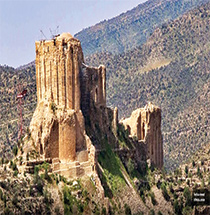Qaleh Dokhtar
A vast barrier Fortress with an inner monumental palace of royal dimensions that is located on a mountain slope near the Firouzabad-Kavar road in Fars province is Qaleh Dokhtar that was built by Ardashir I before his decisive victory against the last Parthian king in 224 A.D.

Description
This castle is a type of structure that you will find in different parts of Iran. Built on more or less the same lines these fortresses are usually strategically located near valleys and plains.
These fortresses were built to protect nearby settlements. Apart from Qaleh Dokhtar importance as a military base, it was also used as a place where ancient Iranians worshipped Anahita, the Goddess of Water. The Zoroastrians regard water, air, light and earth as the four sacred elements in nature and as such go to great lengths to keep water clean and unpolluted. Such fortresses were used to protect water from all impurities.
History of Qal'eh Dokhtar
The name of the castle implies it was dedicated to the Goddess Anahita, to whom the term "Maiden" refers. After capturing Isfahan and Kerman from the Parthians, Ardashir (re)built the city of Gor near the Dokhtar Castle in Firouzabad, making it his capital. After defeating Ardavan V, the parthian king in a great battle in 224 AD, he built the Palace of Ardashir nearby the Dezh Dokhtar structure. Ardashir's grandfather was a prominent priest of the Goddess Anahita at the nearby temple of Darabgird, "City of Darius."
Architecture of the Castle
The shape of the castle is Trapezoid. The area of this fortress is about 2,300 square meters and made of rubble, chalk, and Sarooj. It has a dome that designed unique, but now a little bit of it remains. There is a cave in this castle. In line with what had been said, this cave was linked Dokhtar Castle to Palace of Ardashir to receive essential supplies and soldiers at the imprisonment time. This castle is made up of three levels. After entering the castle, there is a spiral staircase that leads to a courtyard. There are two yards in this castle. In the upper yard, there is a part called Mahtabi. Mahtabi is a no-roof space above the courtyard. This space resembles a porch that has removed the ceiling. There were some rooms in the castle used for guards.